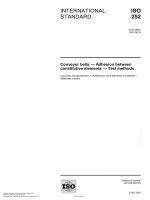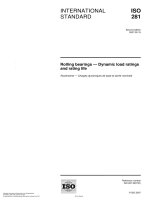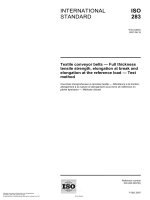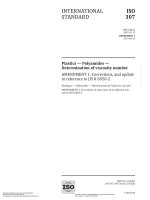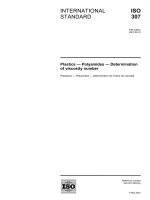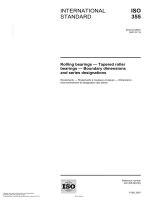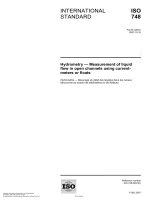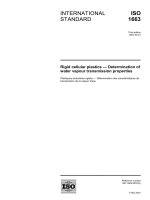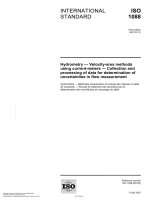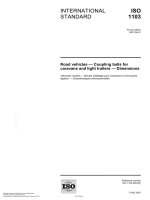Tiêu chuẩn iso 16107 2007
Bạn đang xem bản rút gọn của tài liệu. Xem và tải ngay bản đầy đủ của tài liệu tại đây (254.71 KB, 24 trang )
INTERNATIONAL
STANDARD
ISO
16107
Second edition
2007-10-15
Workplace atmospheres — Protocol for
evaluating the performance of diffusive
samplers
Air des lieux de travail — Protocole pour l'évaluation de la performance
des dispositifs de prélèvement par diffusion
Reference number
ISO 16107:2007(E)
--`,,```,,,,````-`-`,,`,,`,`,,`---
Copyright International Organization for Standardization
Provided by IHS under license with ISO
No reproduction or networking permitted without license from IHS
© ISO 2007
Not for Resale
ISO 16107:2007(E)
PDF disclaimer
This PDF file may contain embedded typefaces. In accordance with Adobe's licensing policy, this file may be printed or viewed but
shall not be edited unless the typefaces which are embedded are licensed to and installed on the computer performing the editing. In
downloading this file, parties accept therein the responsibility of not infringing Adobe's licensing policy. The ISO Central Secretariat
accepts no liability in this area.
Adobe is a trademark of Adobe Systems Incorporated.
--`,,```,,,,````-`-`,,`,,`,`,,`---
Details of the software products used to create this PDF file can be found in the General Info relative to the file; the PDF-creation
parameters were optimized for printing. Every care has been taken to ensure that the file is suitable for use by ISO member bodies. In
the unlikely event that a problem relating to it is found, please inform the Central Secretariat at the address given below.
COPYRIGHT PROTECTED DOCUMENT
© ISO 2007
All rights reserved. Unless otherwise specified, no part of this publication may be reproduced or utilized in any form or by any means,
electronic or mechanical, including photocopying and microfilm, without permission in writing from either ISO at the address below or
ISO's member body in the country of the requester.
ISO copyright office
Case postale 56 • CH-1211 Geneva 20
Tel. + 41 22 749 01 11
Fax + 41 22 749 09 47
Web www.iso.org
Published in Switzerland
ii
Copyright International Organization for Standardization
Provided by IHS under license with ISO
No reproduction or networking permitted without license from IHS
© ISO 2007 – All rights reserved
Not for Resale
ISO 16107:2007(E)
Contents
Page
Foreword............................................................................................................................................................ iv
Introduction ........................................................................................................................................................ v
Scope ..................................................................................................................................................... 1
2
Normative references ........................................................................................................................... 1
3
Terms and definitions........................................................................................................................... 2
4
Symbols and abbreviated terms ......................................................................................................... 2
5
5.1
5.2
5.3
5.4
5.5
5.6
5.7
5.8
5.9
5.10
Summary of test protocol .................................................................................................................... 3
Factors affecting performance ............................................................................................................ 3
“Accuracy” as providing a single performance value linking to measurement uncertainty........ 4
Bias, intersampler variability and the effects of environmental uncertainty.................................. 4
Reverse diffusion.................................................................................................................................. 5
Capacity — Control of effects from interfering compounds ............................................................ 6
Capacity overload detection................................................................................................................ 6
Desorption efficiency ........................................................................................................................... 7
Atmospheric pressure.......................................................................................................................... 7
Wind direction ....................................................................................................................................... 7
Simplifications ...................................................................................................................................... 7
6
6.1
6.2
6.3
Apparatus .............................................................................................................................................. 7
Exposure chamber specifications ...................................................................................................... 7
Controlled environmental conditions ................................................................................................. 8
Inter-run variability ............................................................................................................................... 8
7
Reagents and materials ....................................................................................................................... 9
8
Procedure .............................................................................................................................................. 9
9
Sampler performance classification ................................................................................................... 9
10
10.1
10.2
10.3
Accuracy.............................................................................................................................................. 10
General................................................................................................................................................. 10
Accuracy range confidence limit ...................................................................................................... 10
Expanded uncertainty ........................................................................................................................ 11
11
Test report ........................................................................................................................................... 11
--`,,```,,,,````-`-`,,`,,`,`,,`---
1
Annex A (informative) Worked example — Program for diffusive sampler accuracy range
calculation ........................................................................................................................................... 13
Annex B (informative) Calculation of variances............................................................................................ 15
Bibliography ..................................................................................................................................................... 16
iii
© ISO 2007 – All rights reserved
Copyright International Organization for Standardization
Provided by IHS under license with ISO
No reproduction or networking permitted without license from IHS
Not for Resale
ISO 16107:2007(E)
Foreword
ISO (the International Organization for Standardization) is a worldwide federation of national standards bodies
(ISO member bodies). The work of preparing International Standards is normally carried out through ISO
technical committees. Each member body interested in a subject for which a technical committee has been
established has the right to be represented on that committee. International organizations, governmental and
non-governmental, in liaison with ISO, also take part in the work. ISO collaborates closely with the
International Electrotechnical Commission (IEC) on all matters of electrotechnical standardization.
International Standards are drafted in accordance with the rules given in the ISO/IEC Directives, Part 2.
The main task of technical committees is to prepare International Standards. Draft International Standards
adopted by the technical committees are circulated to the member bodies for voting. Publication as an
International Standard requires approval by at least 75 % of the member bodies casting a vote.
Attention is drawn to the possibility that some of the elements of this document may be the subject of patent
rights. ISO shall not be held responsible for identifying any or all such patent rights.
ISO 16107 was prepared by Technical Committee ISO/TC 146, Air quality, Subcommittee SC 2, Workplace
atmospheres.
--`,,```,,,,````-`-`,,`,,`,`,,`---
This second edition cancels and replaces the first edition (ISO 16107:1999), which has been technically
revised.
iv
Copyright International Organization for Standardization
Provided by IHS under license with ISO
No reproduction or networking permitted without license from IHS
© ISO 2007 – All rights reserved
Not for Resale
ISO 16107:2007(E)
Introduction
Gas or vapor sampling is often accomplished by actively pumping air through a collection medium such as
activated charcoal. Problems associated with a pump, such as inconvenience, inaccuracy and expense, are
inextricable from this type of sampling. The alternative covered by this International Standard is to use
diffusion for moving the compound of interest onto the collection medium. This approach to sampling is
attractive because of the convenience of use and low total monitoring cost.
However, previous studies have found significant problems with the accuracy of some samplers. Therefore,
although diffusive samplers may provide a plethora of data, inaccuracies and misuse of diffusive samplers
may yet affect research studies. Furthermore, worker protection may be based on faulty assumptions. The
aim of this International Standard is to counter the uncertainties in diffusive sampling through achieving a
broadly accepted set of performance tests and acceptance criteria for proving the efficacy of any given
diffusive sampler intended for use.
--`,,```,,,,````-`-`,,`,,`,`,,`---
This International Standard is intended specifically for the large-scale evaluation of many diffusive
sampler/analyte pairs of practical application and is complementary to EN 838. An affordable, experimental
evaluation determines a single performance value indicating how a sampler performs in a typical situation. A
sampler can thereby be quickly judged as to acceptability. Additionally, sufficient data are obtained to predict
performance in many atypical situations. For example, although sampling may normally be done at room
temperature, a particular need may call for use in extreme cold. In such a case, the single performance value
would be superseded by the particular needs.
v
© ISO 2007 – All rights reserved
Copyright International Organization for Standardization
Provided by IHS under license with ISO
No reproduction or networking permitted without license from IHS
Not for Resale
--`,,```,,,,````-`-`,,`,,`,`,,`---
Copyright International Organization for Standardization
Provided by IHS under license with ISO
No reproduction or networking permitted without license from IHS
Not for Resale
INTERNATIONAL STANDARD
ISO 16107:2007(E)
Workplace atmospheres — Protocol for evaluating the
performance of diffusive samplers
1
Scope
This International Standard specifies methods for evaluation of sampler performance in terms of workplace
conditions: wind speed, humidity, temperature, atmospheric pressure, and analyte variation. The concise set
of experiments specified aims to minimize cost to the user. The evaluation is limited to conditions commonly
encountered in personal sampling in the indoor workplace setting, namely wind speeds of up to 0,5 m/s and
for sampling periods typically from 2 h to 8 h.
Static or area sampling, unlike personal sampling where movement of the subject is significant, may
sometimes be subject to sampling-rate reduction due to stagnation at very low wind speeds. This International
Standard therefore does not apply to wind speeds of less than 0,1 m/s relative to static samplers. Samplers
are also tested for compliance with the manufacturer's stated limits on capacity, possibly in the presence of
interfering compounds. Given a suitable exposure chamber, the sampler evaluation protocol can be extended
to cover sampler use for other sampling periods and conditions.
This International Standard indicates how to measure diffusive sampler uncertainty for characterizing
concentration estimates obtained subsequent to the evaluation. It is impractical continually to re-evaluate
diffusive sampler performance under various environmental conditions prevailing during application.
NOTE 1
In this International Standard, the confidence level for the initial method evaluation becomes an integral part of
the measurement uncertainty. This approach slightly broadens the statistical protocols given in ISO Guide 98:1995.
Furthermore, the possibility of sampler errors related to correctible sampler bias is addressed.
NOTE 2
This International Standard is an extension of previous research on diffusive samplers (References [1] to [17]
inclusive and EN 838).
2
Normative references
The following referenced documents are indispensable for the application of this document. For dated
references, only the edition cited applies. For undated references, the latest edition of the referenced
document (including any amendments) applies.
EN 838, Workplace atmospheres — Diffusive samplers for the determination of gases and vapours —
Requirements and test methods
--`,,```,,,,````-`-`,,`,,`,`,,`---
ISO Guide 98:1995, Guide to the expression of uncertainty in measurement. BIPM, IEC, IFCC, ISO, IUPAC,
IUPAP, OIML
1
© ISO 2007 – All rights reserved
Copyright International Organization for Standardization
Provided by IHS under license with ISO
No reproduction or networking permitted without license from IHS
Not for Resale
ISO 16107:2007(E)
3
Terms and definitions
For the purposes of this document, the terms and definitions given in EN 838 and ISO Guide 98:1995 and the
following apply.
3.1
symmetric accuracy range
A
fractional range about the measurand concentration, c, within which 95 % of sampler measurements are found
NOTE
See References [18] to [21] inclusive.
If the modulus of the bias is small, i.e. │∆│ < R/1,645, the symmetric accuracy range, A, can be shown to be closely
approximated (Reference [21]) by Equation (1):
A = 1,960 × ∆ 2 + R 2
(1)
where
∆
is the bias, expressed relative to true concentrations;
R
is the overall true relative standard deviation, expressed relative to true concentrations.
Otherwise
A = | ∆ | + 1,645 × R
(2)
If the bias is corrected, the expected value of ∆2 in Equation (1) becomes equal to the variance of the bias correction,
reflecting an uncorrectable residual bias due to uncertainty in the correction. Then if the bias uncertainty is under control,
the low bias modulus model of Equation (1) indicates the proportionality of A to the root mean squared combined
uncertainty components.
Symbols and abbreviated terms
A
symmetric accuracy range (3.1) in terms of bias and precision
Aest
estimated symmetric accuracy range, A
A95 %
95 % confidence level on the symmetric accuracy range, A
c
true or reference analyte concentration, in milligrams per cubic metre, or parts per million as a ratio of
analyte to air molecules, per instructions of the sampler manufacturer
cest
mean of (four) concentration estimates (including pressure and temperature corrections), in milligrams
per cubic metre or parts per million as a ratio of analyte to air molecules, per instructions of the
sampler manufacturer
h
humidity, partial pressure of water vapor, in kilopascals
n
number of diffusive samplers tested for measuring sampler capacity
p
(atmospheric) pressure
R
overall true relative standard deviation of concentration estimates (dependent on assumed
environmental variability), expressed as a percentage relative to a “true” concentration as estimated
by reference sampling
2
© ISO 2007 – All rights reserved
Copyright International Organization for Standardization
Provided by IHS under license with ISO
No reproduction or networking permitted without license from IHS
Not for Resale
--`,,```,,,,````-`-`,,`,,`,`,,`---
4
ISO 16107:2007(E)
Rest
estimated true relative standard deviation, expressed as a percentage
Rrun
true relative standard deviation characterizing inter-run chamber variability, expressed as a
percentage
Rs
intersampler component of the true relative standard deviation, expressed as a percentage
Rs est
estimated intersampler true relative standard deviation, Rs, expressed as a percentage
Rt
pulse-induced true relative standard deviation, expressed as a percentage
R95 %
95 % confidence limit on the true relative standard deviation, expressed as a percentage
s
estimated standard deviation characterizing intersampler variation
t0,95(ν) value which, at the 95 % probability level, exceeds random variables distributed according to the
Student t-distribution with ν degrees of freedom
T
temperature, in degrees Celsius
u
ambient wind speed, in metres per second
αx
concentration estimate dependence on environmental variable, x (T, h, u, or c)
∆
bias relative to concentration, c
∆est
estimated bias, ∆
∆t
bias associated with concentration pulse
∆95 %
95 % confidence limit on the bias, ∆
ν
degrees of freedom in determining Rs
νeff
effective number of degrees of freedom in determining R
σc
assumed concentration variability
σh
assumed humidity variability
σT
assumed temperature variability
σu
assumed ambient wind speed variability
5
5.1
Summary of test protocol
Factors affecting performance
5.1.1 Diffusive sampling may first of all suffer from error in the sampling rate as stated by the manufacturer
of the sampler. As diffusive samplers are usually used without recalibration, this error implies a bias or
systematic error in all concentration estimates made. As the bias may be in one direction, such error cannot
be minimized by averaging several measurements. If the error is correctible it is not strictly part of the sampler
uncertainty.
--`,,```,,,,````-`-`,,`,,`,`,,`---
3
© ISO for
2007
– All rights reserved
Copyright International Organization
Standardization
Provided by IHS under license with ISO
No reproduction or networking permitted without license from IHS
Not for Resale
ISO 16107:2007(E)
5.1.2 Aside from bias, several sources of random error exist. Some of these errors are associated with the
sampler itself. For example, the sampler’s dimensional tolerance may be low, leading to variation in the
sampling rate, sampler to sampler. The sampler may become overloaded or may not follow concentration
changes adequately.
5.1.3 Other errors relate to a non-constant environment which may affect the sampling rate. Potentially
significant environmental influence quantities include temperature, humidity, wind speed, and atmospheric
pressure. To predict the effect of any such parameter, an experiment on the sampler type may be carried out.
Moreover, the variation expected of the parameter requires estimation. So as to result in a single performance
measure, typical ranges of these environmental parameters are specified in this International Standard.
5.2 “Accuracy” as providing a single performance value linking to measurement
uncertainty
5.2.1 A sampler presented by a manufacturer for evaluation may be found to exhibit both imprecision and
bias. In the language of ISO Guide 98:1995, imprecision and bias together relate to the “accuracy” of a
sampler, rather than “uncertainty”. Accuracy refers to the closeness between measured values and
measurand (in this case the concentration to be measured), whereas uncertainty refers to what is known
about the measurand on the basis of the measurement. In other words, the manufacturer could recommend
use of information about the bias for correction of the measured values. This International Standard provides
means of judging a sampler as recommended for use by a manufacturer.
5.2.2 A useful statistical measure exists which summarizes the overall effect of both random variation and
bias. This function has come to be known as the symmetric accuracy range, A (3.1).
5.2.3 The definition directly implies that A increases with both random error and bias magnitude. Therefore
A is one particular quantification of accuracy as defined in ISO Guide 98:1995. The greater the disparity
between measured values and measurand, the larger the value of A.
NOTE
A is not the only way of quantifying accuracy. For example, the selection of 95 % as coverage level is arbitrary.
Furthermore, other functions consistent with the qualitative idea of accuracy as described in ISO Guide 98:1995 are
possible.
5.2.4 A indicates quantitatively how far off measurements would generally be if further correction of the
sampler were not made. A further advantage of A is that a direct link to the uncertainty described in
ISO Guide 98:1995 is obtained in the case that bias is minimized, e.g. through results of the evaluation.
5.2.5 Moreover, a measurement element not covered extensively within ISO Guide 98:1995 is dealt with
explicitly. Namely, diffusive samplers are generally used as obtained from the manufacturer without
re-evaluation at each use. Therefore, uncertainty in a measured value must account for confidence in the
[single] evaluation itself as well as variation and possible residual bias at the point of use.
5.2.6 The result of approaching uncertainty from the point of view of accuracy results in an “expanded
uncertainty” (in the language of ISO Guide 98:1995) proportional via a “coverage factor” to the root mean
squared combined uncertainty components comprised of bias uncertainty, the effects of sampler variation,
and influence quantities described above. The coverage factor is determined by the confidence required [e.g.,
95 %] in the sampler evaluation and the coverage [also 95 %]. The final result is a value of expanded
uncertainty with specific [tolerance or predictive] meaning, namely, in providing the 95 % coverage range
about the [true] measurand at 95 % confidence in the evaluation.
5.3
Bias, intersampler variability and the effects of environmental uncertainty
5.3.1 This International Standard gives a procedure for assessing the effects of variability in the following
workplace variables: temperature, T; humidity, h (expressed in terms of the water vapor partial pressure to
minimize interaction with the temperature); ambient wind speed, u, across the sampler face [see (5.7)
regarding wind direction]; and concentration, c. An experiment is carried out which provides information about
the dependencies of the concentration estimates on these variables near conditions of intended sampler use
(T0, h0, u0, and c0). Testing is required at the concentration, c0, of intended use, as well as at concentrations
reduced at least to c0/2. Furthermore, the sampler bias and the intersampler standard deviation are measured.
--`,,```,,,,````-`-`,,`,,`,`,,`---
4
Copyright International
Organization for Standardization
Provided by IHS under license with ISO
No reproduction or networking permitted without license from IHS
© ISO 2007 – All rights reserved
Not for Resale
ISO 16107:2007(E)
Finally, the effect of diffusion of material out of the sampler is measured. Pressure effects result in correctable
bias and are not evaluated in this International Standard (5.8).
5.3.2 Using four samplers for each of five experimental runs (the minimum possible), the dependencies αT,
αh, αu, and αc (relative to the chamber reference concentration and target environmental parameters) on
changes in T, h, u, and c are measured, following the sampler manufacturer's instructions regarding pressure
and temperature corrections (if any). These experiments also give a value for the estimated sampler bias, ∆,
relative to the chamber reference concentration (defined for the target conditions). Two further runs describing
time-dependent effects (5.4.5) from diffusive loss of analyte are also carried out. The chamber reference
concentration must be traceable to primary standards of mass and volume.
5.3.3 Error in the estimates of the dependencies αT, αh, αu, and α c will exist on account of the intersampler
component of the true relative standard deviation Rs and an inter-run chamber true relative standard deviation,
Rrun. The latter results in part from uncertainty in the reference concentration. Rs is obtained by pooling the
variance estimates from each run and therefore is estimated with 7 × 3 = 21 degrees of freedom (or
15 degrees of freedom if the reverse diffusion experiment is omitted). So as to avoid re-measurement at each
sampler/analyte evaluation, Rrun is obtained by a separate characterization of the chamber with several runs
at (for example) fixed environmental conditions. An example in which the dependencies α and Rs are
estimated is presented in Annex A.
NOTE
It is up to the user as to how traceability is established. In Reference [12], the concentration estimate, as
calculated from the chamber's analyte generation parameters, is regarded as the “benchmark”, although an independent
estimate is required and must be within 5 % of the calculated estimate. If these estimates differ, then a third independent
estimate is required to establish the reference concentration through agreement with one of the other independent
estimates. One possibility for such an independent estimate is the mean of at least five independent, active sampler
estimates per run within the chamber. Experiment (Reference [12]) on the accuracy of such reference measurements
using sorbent tubes indicates that a true relative standard deviation of the order of 2 % can be achieved for the individual
measurements. Alternatively, Reference [3] requires averaging of at least two independent methods (possibly including
calculated estimates) with at least four samples per method. EN 838 has adopted the looser requirement that calculated
and independent measurements shall agree within 10 %.
5.3.4 A further consolidation of tests may be made by observing that the dependence of concentration
estimates on the wind speed, v, is only sampler specific, i.e. does not depend on the specific analyte.
Therefore, after a single measurement for a given sampler type, the set of tests can be narrowed to five runs
with 5 × 3 = 15 degrees of freedom in the estimate of Rs.
5.4
Reverse diffusion
--`,,```,,,,````-`-`,,`,,`,`,,`---
5.4.1 A potential problem with diffusive samplers is presented by the possibility of reverse diffusion
(sometimes denoted as “back-diffusion” or “off-gassing”) of the analyte. Reverse diffusion is generally only
significant in the case that an analyte is only weakly bound to the sorbent (Reference [6]). Therefore,
inaccuracy associated with these effects may usually be minimized through proper sorbent selection.
5.4.2 Because of reverse diffusion, estimates of a varying concentration may in some cases be biased. The
worst-case situation occurs with the concentration in the form of an isolated pulse at either the beginning or
end of the sampling period. A pulse at the beginning of the period allows the entire sampling period (4 h
to 12 h) for sample loss, possibly resulting in a low estimate relative to a pulse at the end.
5.4.3 In some cases, the time dependence of a specific workplace concentration correlates strongly with the
sampling period. For example, a cleanup operation at the end of a workday could introduce analyte only then.
This could imply a positive bias in the concentration estimates obtained from a day's sampling. For simplicity,
however, this International Standard is designed to assess performance of samplers for use in a concentration
fluctuating in a stationary manner, so that time-dependent effects are treated simply as components of
sampler variance. Specifically, the effect of an isolated 0,5 h pulse occurring at random within the sampling
period is estimated.
5.4.4
Challenging samplers to 0,5 h pulses is similar to the tests of NIOSH (Reference [3]) and EN 838.
5
© ISO 2007 – All rights reserved
Copyright International Organization for Standardization
Provided by IHS under license with ISO
No reproduction or networking permitted without license from IHS
Not for Resale
ISO 16107:2007(E)
5.4.5 Let ∆t (>0) represent one-half the bias between estimates from a 0,5 h pulse at the end versus the
beginning of the sampling period, relative to the mean of the estimates. Assume, conservatively (see, for
example, Reference [6]), that the bias in the estimates of 0,5 h pulse occurring at random within (for example,
an 8 h sampling period ranges uniformly between −∆t and +∆t. Then the variance, R t2 , associated with
sampling a 0,5 h pulse at random within the sampling period is given by Equation (3):
Rt2 =
5.5
1 ∆2
3 t
(3)
Capacity — Control of effects from interfering compounds
5.5.1 This International Standard provides a test for confirming a manufacturer's claimed sampler capacity
under stated conditions of use. Such conditions would normally refer to a specific sampling period and to
environmental extremes, such as 80 % relative humidity at a temperature of 30 °C. Additionally, a
manufacturer may claim a value of capacity for sampling in the presence of specific interferences at stated
concentrations.
5.5.2 For the purposes of this International Standard, capacity is defined as the sampled mass (or
equivalently as the concentration for a specific sampling period) at which concentration estimates are 10 %
low. Specifically, capacity is considered not exceeded if concentration estimates, corrected for correctable
bias, are above 90 % of the true concentration at the 95 % confidence level.
5.5.3 An example of the test is as follows: eight diffusive and eight active samplers are exposed to the
analyte of interest under the stated environmental conditions. Then, neglecting variability in the reference
sampler mean, the 95 % confidence limit ∆µ95 % on the difference in the (unknown) mean concentration
estimates is given by Equation (4):
∆µ 95% = ∆c − [ s × t 0,95 (ν ) / n ]
(4)
where
∆c is the estimated mean difference between diffusive and active results;
s
is the estimated standard deviation characterizing intersampler variation, calculated from the eight
diffusive sampler estimates;
n
is the number of samplers of each type (in this case, 8);
ν
is the number of degrees of freedom (n − 1 = 7).
Then ∆µ95 % shall be greater than −10 % c, where c is the mean concentration estimate from the reference
samplers.
EXAMPLE
Suppose the diffusive sampler component of the true relative standard deviation, Rs = 5 %:
( s / c ) × t 0,95 (ν ) / n = 3.3
(5)
Therefore, in this case the mean value of the diffusive results shall be greater than 93,3 % of the reference concentration.
NOTE
As capacity strongly correlates with sampled mass, a capacity limit expressed as sampled mass at one stated
sampling period is generally applicable to a range of sampling periods.
5.6
Capacity overload detection
The capability to detect capacity overload (e.g. by the use of a second sorbent or by employing paired
samplers with different sampling rates) may be advantageous in some sampling situations. In the case of
active samplers, such detection is easily effected through the use of back-up sections. Therefore, diffusive
samplers with similar features will receive a specific classification. The point is that practicality precludes
6
Copyright International Organization for Standardization
Provided by IHS under license with ISO
No reproduction or networking permitted without license from IHS
--`,,```,,,,````-`-`,,`,,`,`,,`---
© ISO 2007 – All rights reserved
Not for Resale
ISO 16107:2007(E)
testing of the samplers under all conditions of use, such as in an arbitrary multianalyte environment. The
capability of voiding a sample when interferences become demonstrably problematic may therefore be useful.
At present, the efficacy of such breakthrough detection is not evaluated. However, evaluation tests may be
developed in the future for this purpose.
5.7
Desorption efficiency
5.7.1 A further control of the effects from interfering compounds is afforded by restricting the permissible
desorption efficiency. As in Reference [3], the desorption efficiency, in the case of solvent extraction, shall be
>75 % at the concentration of intended application of the sampler. This requirement is expected to control the
potential variation of the desorption efficiency induced by other interfering compounds. The use of internal
standards to compensate for the effect of desorbent evaporation is also generally recommended.
5.7.2
5.8
In the case of thermal desorption, the efficiency shall be >95 %.
Atmospheric pressure
5.8.1 Most diffusive sampler manufacturers provide a formula for correcting for the difference between
atmospheric pressure at points of sampler application and calibration. Unlike the case with temperature,
where sorbent properties may be temperature dependent, the formula is simple: for diffusion through air, the
sampling rate is inversely proportional to the pressure, whereas through a semi-permeable membrane, the
rate is independent of pressure. The difference is because of the differing expansion coefficients of the media
comprised of the scattering molecules.
5.8.2 If the correction formula for a given sampler type is suspected of error, then a simple experiment
using eight samplers at a pressure shifted from the experiments of 5.1 will determine the effect. The test
report [see Clause 11 h)] should give the correctable bias which would be expected under a 15 % shift in the
atmospheric pressure.
5.9
Wind direction
For use in personal sampling, the wind direction is expected to generally have an insignificant effect on
concentration estimates, since the air flow near the body will usually be across the face of the sampler.
Therefore, experiments are done with wind direction parallel to the sampler face.
5.10 Simplifications
--`,,```,,,,````-`-`,,`,,`,`,,`---
Knowledge of similarity between analytes of interest can be used to expedite sampler evaluation. For example,
interpolation of data characterizing the sampling of analytes at separated points of a homologous series of
compounds is recommended. At present the procedure in Reference [9] is suggested: Following evaluation of
a sampler in use at a single homologous series member according to this International Standard, higher
relative molecular mass members would receive partial validations considering sampling rate, capacity,
analytical recovery and interferences. Similarly, testing for diffusive analyte loss can be omitted if the effect is
found negligible for a given sampler or analyte series.
6
Apparatus
6.1
6.1.1
Exposure chamber specifications
Chamber capacity
The chamber shall be capable of exposing at least eight samplers at a time together with required reference
samplers with less than 5 % depletion of test analyte by the samplers at the lowest air flow.
7
© ISO 2007 – All rights reserved
Copyright International Organization for Standardization
Provided by IHS under license with ISO
No reproduction or networking permitted without license from IHS
Not for Resale
ISO 16107:2007(E)
6.1.2
Exposure time
The chamber shall be capable of maintaining conditions for up to 12 h.
Analyte generation
Equipment shall be provided for the measured delivery of gases, or the vaporization and measured dilution in
a mixing chamber at application concentrations of controlled amounts of mixtures of test analytes in the vapor
phase.
6.1.4
Reference concentration measurement
Provision shall be made for simultaneous monitoring of the analyte concentration from at least five locations
within the chamber.
6.1.5
Construction materials
The chamber interior and all parts exposed to the test analytes shall be corrosion resistant and fireproof.
Polypropylene is a likely candidate for this purpose, although stainless steel is preferred as it is less likely to
act as a significant sink.
6.1.6
Monitoring equipment
Monitors for measuring the environmental conditions listed in 6.2 shall be included with the chamber.
6.2
6.2.1
Controlled environmental conditions
Air flow rate
Air flow rates up to 0,5 m/s shall be attainable as velocities across the sampler face as representative of the
local conditions when the sampler is used as a personal sampler.
6.2.2
Humidity variation
Relative humidity equal to (25 ± 5) %, (50 ± 5) % and (80 ± 5) % shall be attainable at 20 °C.
6.2.3
Temperature
Temperatures equal to (10 ± 3) °C, (20 ± 3) °C and (30 ± 3) °C shall be attainable and maintainable. If the
chamber is manufactured of stainless steel, then insulation of the chamber or conditioning of the air entering
the test chamber may be necessary.
6.2.4
Pressure
Pressure within the chamber shall be constant to 1 % within any run and shall be fixed and maintained within
a range of 95 % to 105 % of atmospheric pressure.
6.3
Inter-run variability
The chamber shall be characterized as to inter-run true relative standard deviation, Rrun, through one of
several possible experimental designs. One possibility is through analysis of variance of data from 16 runs
with four samplers each at fixed environmental conditions in the chamber. Experiment on a similar chamber
(Reference [14]) indicated that Rrun < 3 % is attainable.
8
Copyright International Organization for Standardization
Provided by IHS under license with ISO
No reproduction or networking permitted without license from IHS
© ISO 2007 – All rights reserved
Not for Resale
--`,,```,,,,````-`-`,,`,,`,`,,`---
6.1.3
ISO 16107:2007(E)
NOTE
The exposure chamber's specifications (6.1) and environmental conditions (6.2) are sufficient to ensure
effective evaluation of sampler performance in accordance with this International Standard, but do not necessarily exclude
other chamber types.
7
Reagents and materials
Unless otherwise stated, use only reagents of recognized analytical grade and only distilled water or water of
equivalent purity.
Thermal desorption, if used for sample extraction, may obviate the necessity for desorption reagents.
8
Procedure
8.1
Obtain pressure correction formula justification (5.6) from the sampler manufacturer as necessary.
8.2
Following initial characterization, select (for each analyte to be tested) samplers for testing.
8.3 Through five runs with four samplers each, complete the experiments at non-fluctuating concentration
(runs 1, 2, 3, 4, and 5 of Annex A, which also includes the effect of wind speed, u).
--`,,```,,,,````-`-`,,`,,`,`,,`---
8.4 Eight samplers shall also be simultaneously exposed (runs 6 and 7 of Annex A) for 30 min at 80 %
(or greater) relative humidity prior to or during the exposure. Four of the samplers shall be analysed
immediately and four held in a non-stagnant sampling environment at zero analyte concentration for the
remainder (for example, 7,5 h) of the recommended sampling period prior to analysis. The average analyte
mass found for samplers analysed immediately shall be compared to the average quantity found from
samplers held at zero concentration. The magnitude of any decrease (percentage loss relative to the mean
mass) shall be taken as twice the bias (i.e. 2∆t) due to reverse diffusion as described in 5.4. Note that the
concentration of the pulse can be elevated above that of 8.3 if necessary for quantification, as long as the
time-weighted average over sampling periods of intended use is not exceeded.
8.5 Using eight samplers, confirm the manufacturer's claimed limits on the sampler capacity (5.3) in the
presence of manufacturer-stated interfering compounds (including water vapor).
8.6
Measure the desorption efficiency (see Reference [12]).
8.7
Storage stability may be measured as in References [3] and [12] or EN 838.
8.8 Shelf-life of the diffusive sampler in the original package shall be as specified by the manufacturer. At
the end of the shelf-life, the results obtained in accordance with desorption efficiency tests shall not differ by
more than 10 % from the original values.
9
Sampler performance classification
9.1 Data from the experiments described above allow a simple classification of candidate diffusive samplers.
Aside from evidence that the manufacturer's stated sampler capacity (5.3, 8.6) is not excessive, samplers are
to be characterized by their overall accuracy in view of environmental variability.
9.2 For evaluating the symmetric accuracy range, A [Equation (1)], the square of the estimated total true
relative standard deviation Rest is given by propagation of errors in terms of its independent components by
Equation (6):
2
R est
= R t2 + R s2 + α T2 R T2 + α h2 R h2 + α u2 R u2 + α c2 R c2
9
© ISO 2007 – All rights reserved
Copyright International Organization for Standardization
Provided by IHS under license with ISO
No reproduction or networking permitted without license from IHS
(6)
Not for Resale
ISO 16107:2007(E)
where RT, Rh, Ru, and Rc represent the (inter-day) coefficients of variation of the temperature, humidity, wind
speed, and concentration expected in the workplace, and the sampler dependencies, α, are as described
in 5.3.
9.3 In order to assess the accuracy of a diffusive sampler as applied in a specific workplace, these
environmental dependencies require characterization. However, sampler classification is obtained here by
adopting nominal values for these four quantities, namely
σT = 5 °C (T0 ≈ 25 °C)
(7)
σh = 0,5 kPa (h0 ≈ 1,0 kPa)
(8)
σu = 0,25 m/s (u0 ≈ 0,50 m/s)
(9)
Rc = 30 %
(10)
EXAMPLE
σT = 5 °C corresponds to sampler use (95 % of the time) between 15 °C and 35 °C. Similarly,
σu = 0,25 m/s covers wind speeds as observed in most indoor workplaces (Reference [22]).
NOTE
If the respective environmental dependencies are expected to be less than the nominal values given by
Equations (7) to (10), then the calculated sampler accuracy is a conservative estimate. Alternatively, if a manufacturer
explicitly states that a sampler is to be used over a narrow environmental range, the accuracy can and should be
computed correspondingly.
10 Accuracy
10.1 General
This International Standard provides an estimate of the accuracy of a candidate diffusive sampler under
evaluation. Because the evaluation is not perfect, the accuracy estimate itself may be biased or imprecise.
The uncertainty in the estimated accuracy is therefore characterized here by computing a conservative 95 %
confidence level on the accuracy.
10.2 Accuracy range confidence limit
For computing the 95 % confidence level on the symmetric accuracy range, A95 %, an algorithm similar to an
approximation developed in References [23] and [24] for confidence limits on linear combinations of
independent variance estimates has been found accurate and simple to implement. Namely, random variation
in the estimate Aest is approximated in terms of a random variable, χν2 , for the cases in Equations (1) and
eff
(2) by Equations (11) and (12):
Aest/A =
⎧ √(χ 2/νeff)
⎨ 2
⎩ χ /νeff
if │∆│< R/1,645
(11)
otherwise
(12)
2
The effective number of degrees of freedom νeff is determined by forcing the variance of χν
to reproduce
eff
2
the estimated variance of Aest
or Aest in their respective cases:
if │∆│< R/1,645
(13)
otherwise
(14)
--`,,```,,,,````-`-`,,`,,`,`,,`---
νeff =
2
⎧ 2A4/var[ Aest
]
⎨
⎩ 2A2/var[Aest]
10
Copyright International Organization for Standardization
Provided by IHS under license with ISO
No reproduction or networking permitted without license from IHS
© ISO 2007 – All rights reserved
Not for Resale
ISO 16107:2007(E)
2
Calculation of var[ Aest
] or var[Aest] is straightforward, using any mathematics program which can handle the
calculation of matrix inverses. More details are given in Reference [14] and reproduced in Annex B, but are
invisible to the user of a computer program available at: />2
:
The confidence limit A95% is then easily found using a table of chi-square quantiles χ 0.05,
ν eff
2
⎧ Aest × √(νeff/ χ 0.05,ν eff )
⎨
2
⎩ Aest × (νeff/ χ 0.05,ν eff )
A95 % =
if │∆│< R/1,645
(15)
otherwise
(16)
10.3 Expanded uncertainty
The symmetric accuracy range, A, is for specifying confidence intervals on an unknown concentration, cx.
Suppose the likelihood that |A95 %| > 100% is negligible. Then at 95 % confidence in the method evaluation,
c x,est
1 + A95 %
< cx <
c x,est
1 − A95 %
,
(17)
--`,,```,,,,````-`-`,,`,,`,`,,`---
for more than 95 % of the estimates, cx,est. Such double-confidence intervals are the counterpart to the
expanded uncertainty (coverage factor together with combined uncertainty) of ISO Guide 98:1995 in the case
of negligible bias (acknowledging as described in 5.2.1 that, though important, known bias, aside from its own
uncertainty as accounted for here, does not contribute to uncertainty in a concentration estimate since biased
estimates may be corrected).
11 Test report
Several alternatives exist for using the results of the experimental evaluations described here. For example,
EN 838, on diffusive sampler requirements, suggests classifying the samplers according to specific accuracy
criteria. Alternatively, the NIOSH accuracy criterion (References [18] to [21] inclusive) presents a pass/fail
requirement that acceptable sampling methods have better than 25 % accuracy at the 95 % (evaluation)
confidence level and that the uncorrected modulus of the bias is <10 %. The accuracy itself may, in fact, be
defined in alternative manners. Here, it is suggested simply that sufficient information is presented that a large
number of such performance criteria suited for specific application can be easily implemented. Therefore, as a
minimum, the following should appear in the test report of the sampler evaluation:
a)
analytes used for sampler test;
b)
list of the model parameters determined from the experimental data;
c)
overall accuracy of the sampler;
d)
95 % confidence limit on the sampler overall accuracy;
e)
statement that the manufacturer's claimed sampler capacity was or was not exceeded in the case of
single-analyte tests and also in the presence of listed interfering compounds at stated concentrations;
f)
statement as to whether the sampler provides a means of detecting breakthrough;
g)
statement as to whether the uncorrected modulus of the bias is <10 %;
h)
if appropriate, a statement as to the correctable bias determined from a 15 % change in atmospheric
pressure, calculated according to manufacturer advice if available.
11
© ISO 2007 – All rights reserved
Copyright International Organization for Standardization
Provided by IHS under license with ISO
No reproduction or networking permitted without license from IHS
Not for Resale
ISO 16107:2007(E)
Samplers tested to this protocol shall be preferred in use over samplers tested to a lower level of evaluation
(e.g. calculated uptake rates).
Samplers tested to a protocol considered an equal or greater level of evaluation (e.g. EN 838 or
Reference [3]) do not require re-testing to be considered as having met the requirements of this protocol.
--`,,```,,,,````-`-`,,`,,`,`,,`---
NOTE
Samplers used outside the ranges of environmental conditions chosen either for the tests or for intended
application (9.3) in this protocol do not provide results of assured accuracy. For example, this International Standard does
not address sampling in an environment with a correlated combination of high temperature, high humidity and high
concentration with interference.
12
Copyright International Organization for Standardization
Provided by IHS under license with ISO
No reproduction or networking permitted without license from IHS
© ISO 2007 – All rights reserved
Not for Resale
ISO 16107:2007(E)
Annex A
(informative)
Worked example — Program for diffusive sampler accuracy
range calculation
Table A.1 and corresponding data analysis via an input/output form for a computer program (Table A.2)
illustrate the experiments and calculations described in this practice (see: />Table A.1 — Experimental design with seven runs for covering a range of environmental conditions
Run
Temperature
Humidity
Windspeed
Concentration
1
target
high
target
target
2
target
low
target
target
3
target
low
target
low
4
target
target
high
low
5
high
low
target
target
6 (degassed pulse)
7 (non-degassed pulse)
Table A.2 — Diffusive sampler performance: Test results and accuracy analysis for four
candidate sampler replicates per run
Input
Chamber conditions
Replicates (ppm)
Run 1: T = 25 °C; h = 2,59 kPa; u = 0,11 m/s
139,2
True concentration (ppm)
123
138,2
138,6
145
Run 2: T = 25,1 °C; h = 0,48 kPa; u = 0,11 m/s
108,3
True concentration (ppm)
101,1
110
110,7
112,8
Run 3: T = 25,1 °C; h = 0,48 kPa; u = 0,11 m/s
14,2
True concentration (ppm)
12,7
15,3
12,9
14,6
--`,,```,,,,````-`-`,,`,,`,`,,`---
13
© ISO 2007 – All rights reserved
Copyright International Organization for Standardization
Provided by IHS under license with ISO
No reproduction or networking permitted without license from IHS
Not for Resale
ISO 16107:2007(E)
Table A.2 (continued)
Input
Chamber conditions
Replicates (ppm)
Run 4: T = 26,7 °C; h = 1,59 kPa; u = 0,5 m/s
14,9
True concentration (ppm)
11,5
14,6
15,3
15
Run 5: T = 39 °C; h = 0,33 kPa; u = 0,11 m/s
109
True concentration (ppm)
91,3
109,2
107,1
105
Run 6: Pulse period = 30 min; degassing period = 7,5 h
139
--`,,```,,,,````-`-`,,`,,`,`,,`---
True concentration (ppm)
135
140
140
140
Run 7: Pulse period = 30 min; degassing period = 0,0 h
144
True concentration (ppm)
135
145
138
139
Application concentration (ppm) = 50
Rrun = 0,008 693 183
Output: Performance test accuracy summary
Percentage
Accuracy range
28,65
95 % Accuracy range confidence limit
31,03
Bias
18,12
True relative standard deviation, R
6,40
Intersampler component of the true relative standard deviation, Rs
2,86
Percentage accuracy range dependencies on:
Sampler
Percentage effect
Bias
88,90
Intersampler variation
2,21
Reverse diffusion
0,03
Environment
Temperature variation
2,61
Humidity variation
0,84
Wind speed variation
5,33
Concentration variation
0,07
14
Copyright International Organization for Standardization
Provided by IHS under license with ISO
No reproduction or networking permitted without license from IHS
© ISO 2007 – All rights reserved
Not for Resale
